child seat HONDA PRELUDE 1998 Owners Manual
[x] Cancel search | Manufacturer: HONDA, Model Year: 1998, Model line: PRELUDE, Model: HONDA PRELUDE 1998Pages: 278, PDF Size: 2.61 MB
Page 4 of 278
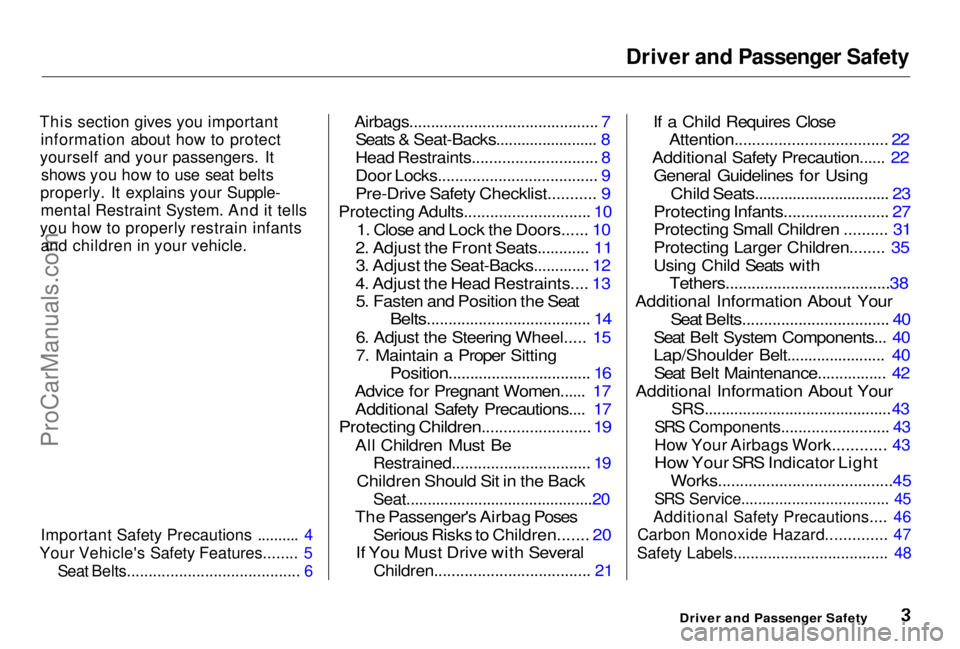
Driver and Passenger Safety
This section gives you important information about how to protect
yourself and your passengers. It shows you how to use seat belts
properly. It explains your Supple- mental Restraint System. And it tells
you how to properly restrain infants and children in your vehicle.
Important Safety Precautions .......... 4
Your Vehicle's Safety Features........ 5 Seat Belts........................................ 6
Airbags............................................ 7
Seats & Seat-Backs........................ 8
Head Restraints............................. 8
Door Locks..................................... 9
Pre-Drive Safety Checklist........... 9
Protecting Adults............................. 10
1. Close and Lock the Doors...... 10
2. Adjust the Front Seats............ 11 3. Adjust the Seat-Backs............. 12
4. Adjust the Head Restraints.... 13 5. Fasten and Position the Seat
Belts...................................... 14
6. Adjust the Steering Wheel..... 15
7. Maintain a Proper Sitting
Position................................. 16
Advice for Pregnant Women...... 17 Additional Safety Precautions.... 17
Protecting Children.........................
19
All Children
Must Be
Restrained................................ 19
Children Should Sit in the Back
Seat............................................20
The Passenger's Airbag Poses
Serious Risks to Children....... 20
If You Must Drive with Several
Children.................................... 21
If a Child Requires Close
Attention................................... 22
Additional Safety Precaution...... 22 General Guidelines for Using
Child Seats................................ 23
Protecting Infants........................ 27
Protecting Small Children .......... 31
Protecting Larger Children........ 35
Using Child Seats with
Tethers......................................38
Additional Information About Your
Seat Belts.................................. 40
Seat Belt System Components... 40
Lap/Shoulder Belt....................... 40 Seat Belt Maintenance................ 42
Additional Information About Your
SRS............................................
43
SRS Components........................ .
43
How Your Airbags Work............ 43
How Your SRS Indicator Light
Works........................................45
SRS Service................................... 45
Additional Safety Precautions.... 46
Carbon Monoxide Hazard.............. 47
Safety Labels.................................... 48
Driver and Passenger SafetyProCarManuals.comMain Menu s t
Page 5 of 278
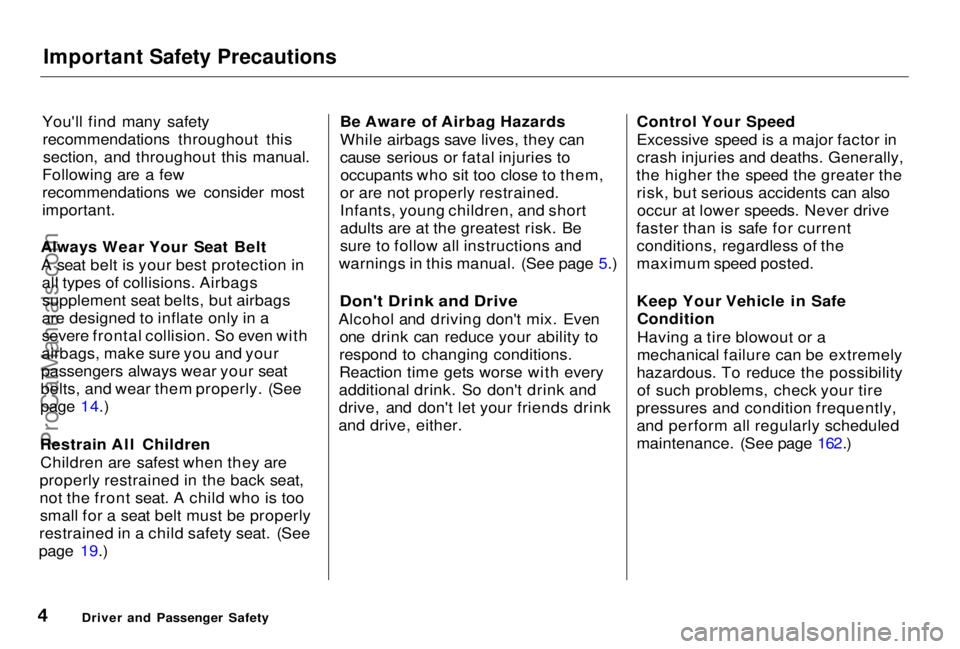
Important Safety Precautions
You'll find many safety recommendations throughout thissection, and throughout this manual.
Following are a few
recommendations we consider most
important.
Always Wear Your Seat Belt A seat belt is your best protection in all types of collisions. Airbagssupplement seat belts, but airbags
are designed to inflate only in a
severe frontal collision. So even with
airbags, make sure you and your
passengers always wear your seat
belts, and wear them properly. (See
page 14.)
Restrain All Children Children are safest when they are
properly restrained in the back seat,
not the front seat. A child who is too small for a seat belt must be properly
restrained in a child safety seat. (See
page 19.) Be Aware of Airbag Hazards
While airbags save lives, they can
cause serious or fatal injuries to
occupants who sit too close to them,
or are not properly restrained.
Infants, young children, and short
adults are at the greatest risk. Be
sure to follow all instructions and
warnings in this manual. (See page 5.)
Don't Drink and Drive
Alcohol and driving don't mix. Even one drink can reduce your ability to
respond to changing conditions.
Reaction time gets worse with every
additional drink. So don't drink and
drive, and don't let your friends drink
and drive, either. Control Your Speed
Excessive speed is a major factor in
crash injuries and deaths. Generally,
the higher the speed the greater the risk, but serious accidents can alsooccur at lower speeds. Never drive
faster than is safe for current conditions, regardless of the
maximum speed posted.
Keep Your Vehicle in SafeCondition
Having a tire blowout or a
mechanical failure can be extremely
hazardous. To reduce the possibility of such problems, check your tire
pressures and condition frequently, and perform all regularly scheduled
maintenance. (See page 162.)
Driver and Passenger SafetyProCarManuals.comMain Menu Table of Contents s t
Page 7 of 278
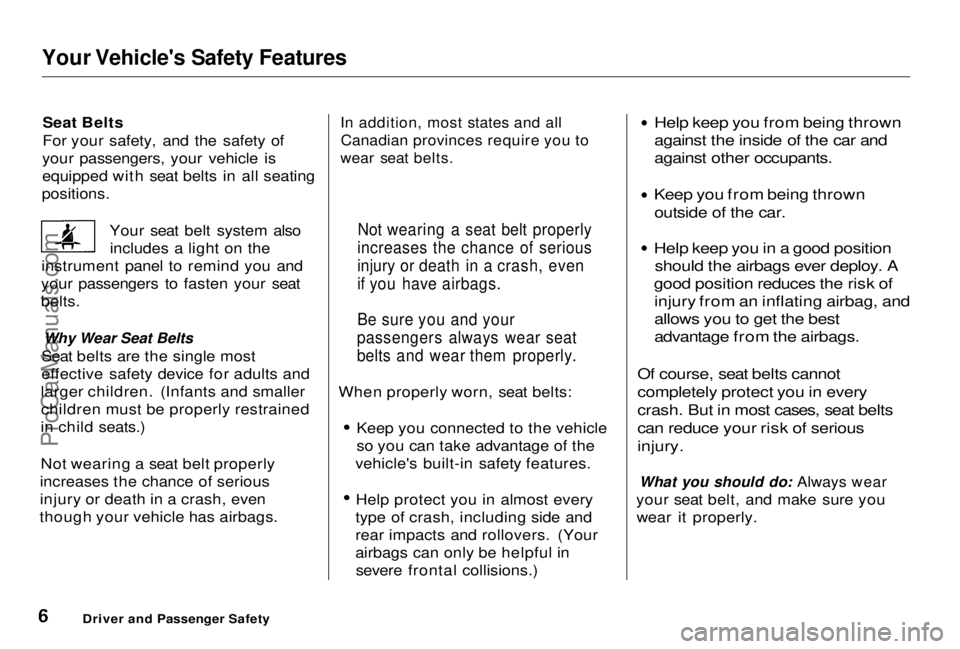
Your Vehicle's Safety Features
Seat Belts
For your safety, and the safety of
your passengers, your vehicle is
equipped with seat belts in all seating
positions.
Your seat belt system alsoincludes a light on the
instrument panel to remind you and
your passengers to fasten your seat
belts.
Why Wear Seat Belts
Seat belts are the single most
effective safety device for adults and
larger children. (Infants and smaller children must be properly restrained
in child seats.)
Not wearing a seat belt properly
increases the chance of serious
injury or death in a crash, even
though your vehicle has airbags.
In addition, most states and all
Canadian provinces require you to
wear seat belts.
When properly worn, seat belts: Keep you connected to the vehicle
so you can take advantage of the
vehicle's built-in safety features.
Help protect you in almost every
type of crash, including side and
rear impacts and rollovers. (Your
airbags can only be helpful in severe frontal collisions.)
Help keep you from being thrown
against the inside of the car and
against other occupants.
Keep you from being thrown
outside of the car.
Help keep you in a good position
should the airbags ever deploy. A
good position reduces the risk of
injury from an inflating airbag, and
allows you to get the best
advantage from the airbags.
Of course, seat belts cannot
completely protect you in every
crash. But in most cases, seat belts
can reduce your risk of serious
injury.
What you should do: Always wear
your seat belt, and make sure you wear it properly.
Driver and Passenger Safety
Not wearing a seat belt properly
increases the chance of serious
injury or death in a crash, even
if you have airbags.
Be sure you and your
passengers always wear seat
belts and wear them properly.
ProCarManuals.comMain Menu Table of Contents s t
Page 8 of 278
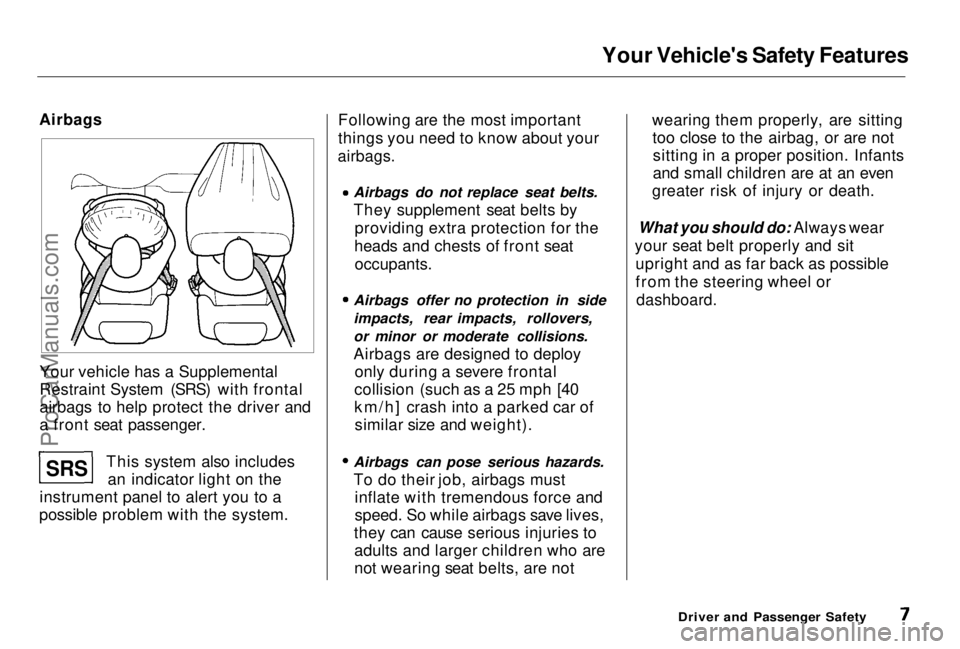
Your Vehicle's Safety Features
Airbags
Your vehicle has a Supplemental
Restraint System (SRS) with frontal
airbags to help protect the driver and
a front seat passenger. This system also includesan indicator light on the
instrument panel to alert you to a
possible problem with the system. Following are the most important
things you need to know about your
airbags.
Airbags do not replace seat belts.
They supplement seat belts byproviding extra protection for the
heads and chests of front seat
occupants.
Airbags offer no protection in side
impacts, rear impacts, rollovers,
or minor or moderate collisions.
Airbags are designed to deploy
only during a severe frontal
collision (such as a 25 mph [40
km/h] crash into a parked car of similar size and weight). Airbags can pose serious hazards.
To do their job, airbags must
inflate with tremendous force and
speed. So while airbags save lives,
they can cause serious injuries to adults and larger children who are
not wearing seat belts, are not wearing them properly, are sitting
too close to the airbag, or are notsitting in a proper position. Infants
and small children are at an even
greater risk of injury or death.
What you should do: Always wear
your seat belt properly and sit upright and as far back as possible
from the steering wheel or
dashboard.
Driver and Passenger Safety
SRS
ProCarManuals.comMain Menu Table of Contents s t
Page 10 of 278
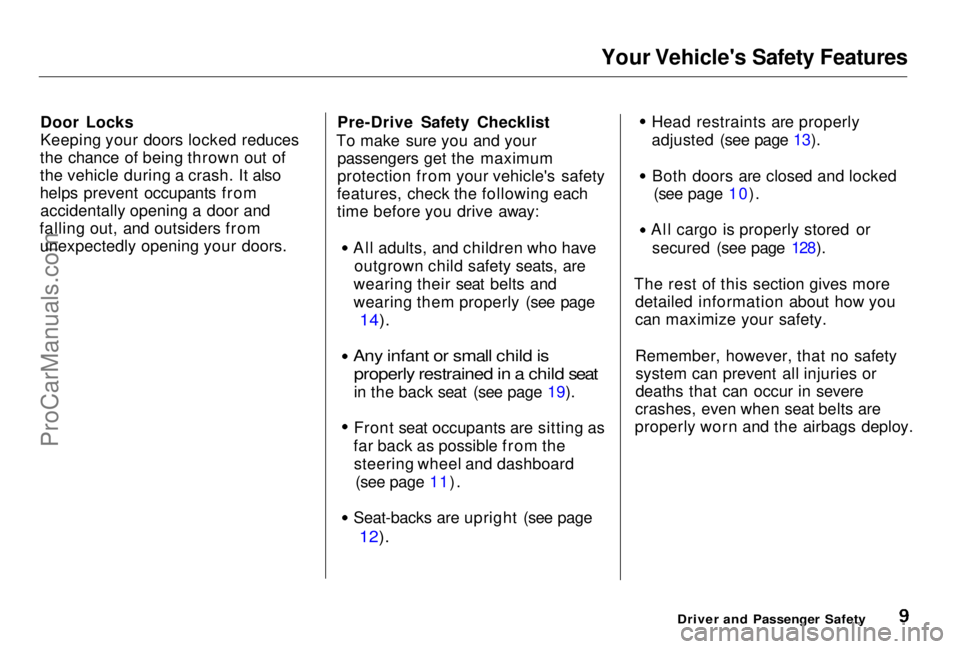
Your Vehicle's Safety Features
Door Locks
Keeping your doors locked reduces
the chance of being thrown out of
the vehicle during a crash. It also
helps prevent occupants from accidentally opening a door and
falling out, and outsiders from unexpectedly opening your doors. Pre-Drive Safety Checklist
To make sure you and your passengers get the maximum
protection from your vehicle's safety
features, check the following each
time before you drive away:
All adults, and children who haveoutgrown child safety seats, are
wearing their seat belts and
wearing them properly (see page
14).
Any infant or small child is properly restrained in a child seat
in the back seat (see page 19). Front seat occupants are sitting as
far back as possible from the steering wheel and dashboard (see page 11).
Seat-backs are upright (see page
12).
Head restraints are properly
adjusted (see page 13). Both doors are closed and locked
(see page 10). All cargo is properly stored or
secured (see page 128).
The rest of this section gives more detailed information about how you
can maximize your safety.
Remember, however, that no safetysystem can prevent all injuries or
deaths that can occur in severe
crashes, even when seat belts are
properly worn and the airbags deploy.
Driver and Passenger SafetyProCarManuals.comMain Menu Table of Contents s t
Page 11 of 278
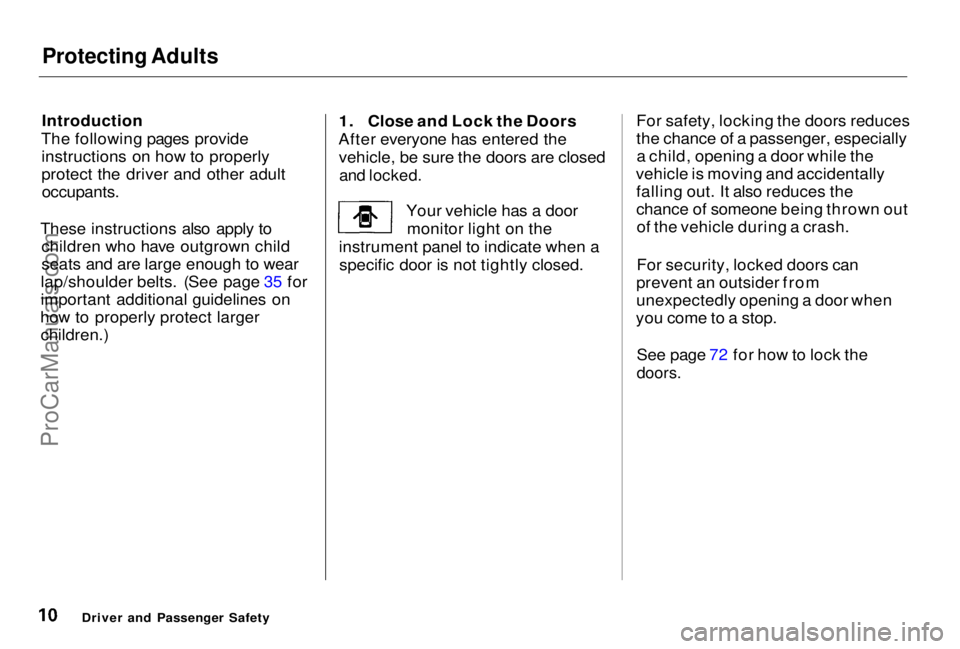
Protecting Adults
Introduction
The following pages provide instructions on how to properly
protect the driver and other adult
occupants.
These instructions also apply to children who have outgrown child
seats and are large enough to wear
lap/shoulder belts. (See page 35 for
important additional guidelines on
how to properly protect larger children.) 1. Close and Lock the Doors
After everyone has entered the vehicle, be sure the doors are closed
and locked.
Your vehicle has a doormonitor light on the
instrument panel to indicate when a specific door is not tightly closed. For safety, locking the doors reduces
the chance of a passenger, especially
a child, opening a door while the
vehicle is moving and accidentally falling out. It also reduces the
chance of someone being thrown outof the vehicle during a crash.
For security, locked doors can
prevent an outsider from
unexpectedly opening a door when
you come to a stop.
See page 72 for how to lock the
doors.
Driver and Passenger SafetyProCarManuals.comMain Menu Table of Contents s t
Page 18 of 278
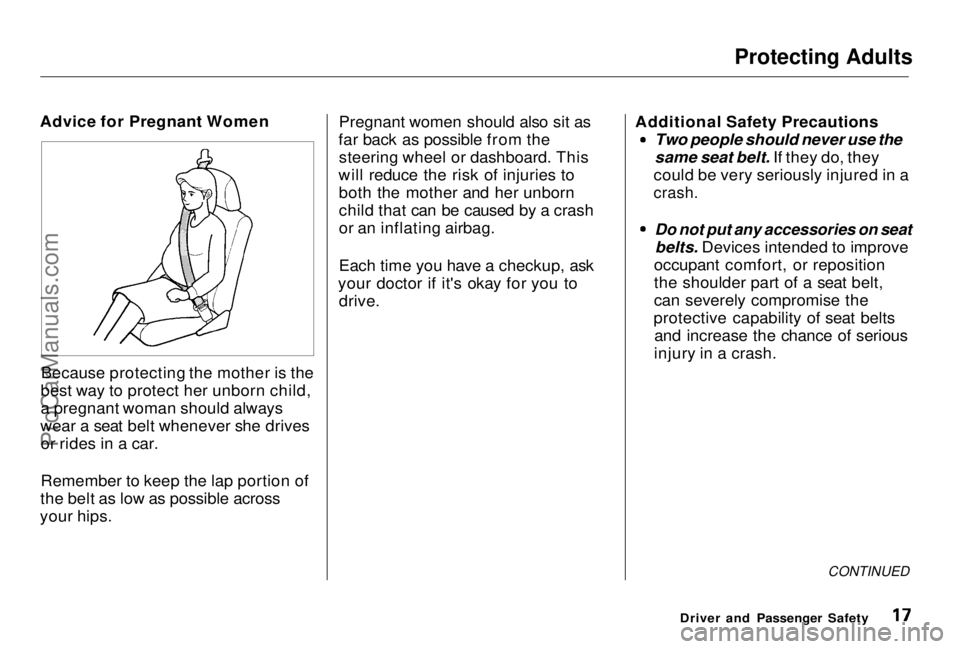
Protecting Adults
Advice for Pregnant Women
Because protecting the mother is the
best way to protect her unborn child,
a pregnant woman should always
wear a seat belt whenever she drives or rides in a car.
Remember to keep the lap portion of
the belt as low as possible across
your hips. Pregnant women should also sit as
far back as possible from the steering wheel or dashboard. This
will reduce the risk of injuries to both the mother and her unborn
child that can be caused by a crash
or an inflating airbag.
Each time you have a checkup, ask
your doctor if it's okay for you to drive. Additional Safety Precautions
Two people should never use the
same seat belt. If they do, they
could be very seriously injured in a
crash.
Do not put any accessories on seat
belts. Devices intended to improve
occupant comfort, or reposition
the shoulder part of a seat belt,
can severely compromise the
protective capability of seat belts and increase the chance of serious
injury in a crash.
CONTINUED
Driver and Passenger SafetyProCarManuals.comMain Menu Table of Contents s t
Page 20 of 278
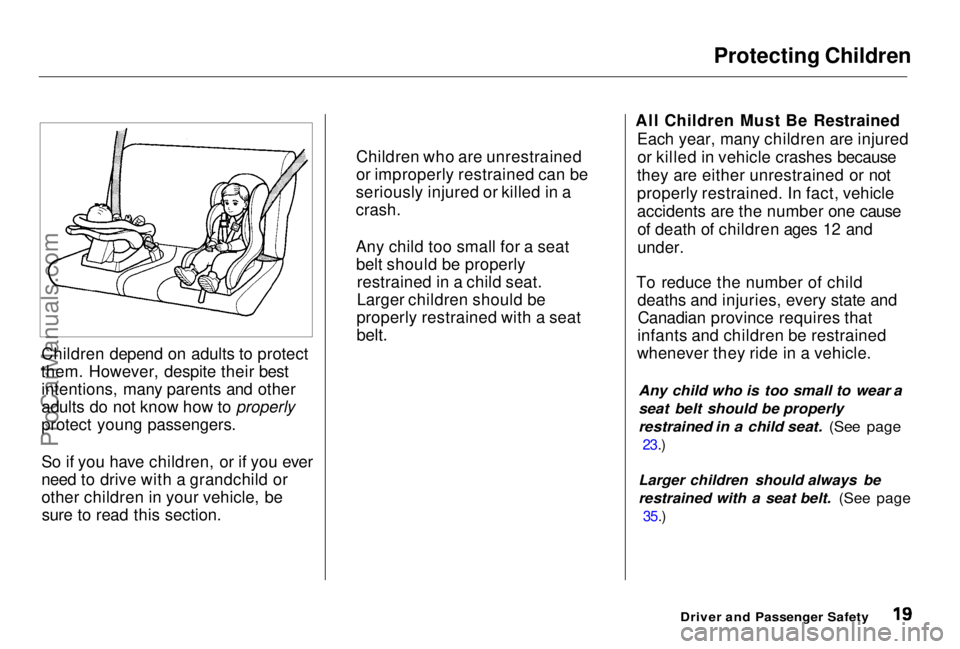
Protecting Children
Children depend on adults to protect
them. However, despite their best intentions, many parents and other
adults do not know how to properly
protect young passengers.
So if you have children, or if you ever
need to drive with a grandchild or
other children in your vehicle, besure to read this section. All Children Must Be Restrained
Each year, many children are injuredor killed in vehicle crashes because
they are either unrestrained or not
properly restrained. In fact, vehicle
accidents are the number one cause of death of children ages 12 and
under.
To reduce the number of child deaths and injuries, every state andCanadian province requires that
infants and children be restrained
whenever they ride in a vehicle.
Any child who is too small to wear a
seat belt should be properly
restrained in a child seat. (See page
23.)
Larger children should always be
restrained with a seat belt. (See page
35.)
Driver and Passenger Safety
Children who are unrestrained
or improperly restrained can be
seriously injured or killed in a
crash.
Any child too small for a seat belt should be properly restrained in a child seat.
Larger children should be
properly restrained with a seat
belt.ProCarManuals.comMain Menu Table of Contents s t
Page 21 of 278

Protecting Children
Children Should Sit in the Back
Seat
According to accident statistics, children of all ages and sizes are
safer when they are restrained in the
back seat, not the front seat. The National Highway Traffic Safety
Administration recommends that all children ages 12 and under ride in
the back seat, properly restrained.
In the back seat, children are less
likely to be injured by striking hard interior vehicle parts during a
collision or hard braking. Also,
children cannot be injured by an inflating airbag when they ride in the
back. The Passenger's Airbag Poses
Serious Risks to Children
Airbags have been designed to help protect adults in a severe frontal
collision. To do this, the passenger's
airbag is quite large, and it inflates
with tremendous speed.
Infants
Never put a rear-facing child seat in
the front seat of a vehicle equipped
with a passenger's airbag. If the
airbag inflates, it can hit the back of
the child seat with enough force to
kill or very seriously injure an infant.
Small Children
Placing a forward-facing child seat in
the front seat of a vehicle equipped
with a passenger's airbag can be
hazardous. If the vehicle seat is too
far forward, or the child's head is
thrown forward during a collision, an inflating airbag can strike the child
with enough force to kill or very seriously injure a small child.
Larger Children
Children who have outgrown child
seats are also at risk of being injured
or killed by an inflating passenger
airbag. Whenever possible, larger
children should sit in the back seat,
properly restrained with a seat belt. (See page 35 for important
information about protecting larger
children.)
Driver and Passenger SafetyProCarManuals.comMain Menu Table of Contents s t
Page 22 of 278

Protecting Children
U.S. Models
To remind you of the passenger's airbag hazards, and that children
must be properly restrained in the
back seat, your vehicle has warning
labels on the dashboard and on the driver's and front passenger's visors.
Please read and follow the
instructions on these labels. If You Must Drive with Several
Children
Your vehicle has two seating positions in the back seat where
children can be properly restrained.
If you ever have to carry more than
two children in your vehicle: Place the largest child in the front
seat, provided the child is large
enough to wear a seat belt
properly (see page 35).
Move the vehicle seat as far to the
rear as possible (see page 11).
Have the child sit upright and well
back in the seat (see page 16).
Make sure the seat belt is properly
positioned and secured (see page
14).
Driver and Passenger SafetyProCarManuals.comMain Menu Table of Contents s t